Compelling. That’s probably the last word you’d think of when someone mentions ‘Silvertone acoustic guitars’. Therein lies the mistake most make, underestimating the gritty allure of these underestimated gems.
Peel back the unfamiliarity, and you encounter rich decade-old histories, a surprisingly exquisite sound beneath the modest looks, and an unexpected, yet delightful grit that has me, Richard Miller, spellbound till today. I’m not just another fingerstyle guitarist; I’m an avid Silvertone devotee, ever since the first strum amplified a rustic resonance that drowned every preconceived notion I ever harbored. It was an encounter that birthed a profound change in my perception, an encounter that I’m eager to share… but not just yet.
Chemistry struck with Silvertone guitars isn’t based on fleeting fascination. It’s rooted in the unique personality that each Silvertone acoustic model exudes, leaving an indelible impression, while compelling you to explore further. And that’s what I’m here for – to take you on this exciting journey of exploration through Silvertone’s labyrinth of captivating acoustic models.
Consider this a well-versed guide, sprouting from countless hours of tuning, strumming, tweaking, performing with these underrated marvels – experiences that unravelled their underlying potency, unique aesthetics, and peculiar quirks – experiences I’m thrilled to recount, in the hopes that you too will discover the irresistible charm of Silvertone’s acoustic offerings.
So, ready to delve into the audacious allure of Silvertone acoustic guitars?
History of Silvertone Guitars
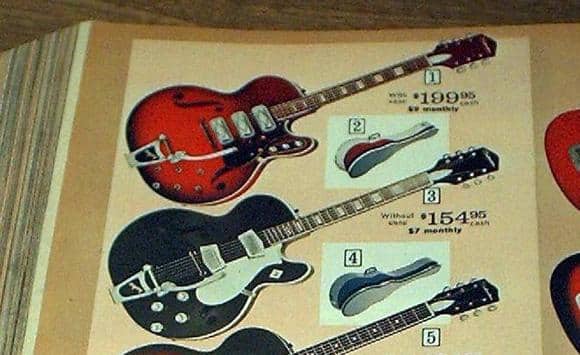
In my years of playing and studying various musical genres, I’ve developed a deep appreciation for the rich tapestry of stories that each guitar carries. The tonal qualities of a guitar are not simply a result of the design and construction, but are heavily influenced by the brand’s story. This unique blend of craftsmanship and history is particularly strong in one brand I’ve always admired – Silvertone. I would love to share with you the enamoring Silvertone guitar history that has shaped the tonal qualities of these instruments, leaving a legacy that is embedded into every strum.
Ever wondered about the stories etched into the wood of your beloved guitar? Join me as we delve into the storied heritage that has marinated the classic Silvertone acoustic guitars with a distinctive sound, resonating with the soul of music itself.
The chronicle of the Silvertone brand goes back to the early 20th century, when it was first introduced by Sears, Roebuck and Co. initially, as a line of phonographs. As their reputation quickly burgeoned for inventing quality products for the layman, they ventured into creating musical instruments – particularly, guitars. The Silvertone brand reputation was built on the principle of ‘quality instruments for everyone’, which still rings true to this day.
The mid-century saw the real blossoming of the Silvertone guitar range, with the advent of models that were affordable and ideal for novices, yet offering the quality to satisfy seasoned musicians. This was a game-changing period in Silvertone guitar history, making music more accessible to the masses, and etching an indelible mark on the landscape of American popular music.
As a musician, I can attest to the lasting impact of this legacy on the guitars themselves. Their rich heritage permeates through their tonal quality. Every time clarity of notes wafts from a Silvertone, one cannot escape the sense of being connected to all the musicians before who’ve strummed a similar model. It’s a feeling I wish to share with every music lover, the harmony of unity that reverberates with the plucking of those strings.
As we continue our journey through the world of Silvertone acoustic guitars in the next chapters, let this historical perspective enrich your understanding of the brand. Consider the impact of this history on every aspect of these guitars, from the design and craftsmanship to the tonal quality and playability. It’s the legacy that has defined the brand and will keep it relevant in the years to come.
So, as we transition to a more specific appraisal of Silvertone Acoustic Guitar Models, remember this history, remember the legacy, remember the stories that are etched into every piece of wood that has made the Silvertone guitars we know and love today.
Silvertone Acoustic Guitar Models
Silvertone 600 Series Overview
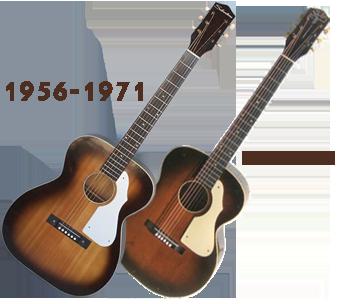
I remember the first time I plucked the strings of a Silvertone 600 series guitar. The well-rounded, mellifluous tone that rang out stunned me quiet. That unique and balanced auditory experience was like a siren’s call, prompting me to unfurl the mysteries of this beautiful model that soon found a special place in my cherished collection.
Like the different siblings in the Silvertone acoustic guitar family, the Silvertone 600 series has its distinctive characteristics. Its unique feature is undeniably the Silvertone solid spruce top. Blessing the guitar with its resonance, the spruce top ensures that the tonality of these models retains a rich charisma, despite the passage of time or changing temperature and humidity conditions.
The Silvertone 600 series guitar also offers a balanced and harmonious sound output, perfect for both solo performances and integrated band play. The strings respond beautifully to fingerpicking styles and don’t miss a beat when strummed with a pick. It is this versatility that not only won my heart but also the admiration of many other music enthusiasts.
In the grand scheme of Silvertone Acoustic Guitar Models, the 600 series emerges as a timeless gem. It echoes a rich history while resonating with a modern freshness, making this series a truly engaging combination of tradition and innovation. Engaging with this instrument provides an optimal base for guitarists to comprehend the unique properties of each model within Silvertone’s distinctive catalogue, allowing them to make informed choices about which model suits their musical styles and preferences.
From my experience, the Silvertone 600 series undoubtedly added a novel flavor to my acoustic collection, shifting my perceptions and deepening my understanding of the acoustic guitar universe. As we move into the particulars of orchestra body acoustic guitar characteristics, I hope you’ll find similar enlightenment and even greater motivation to explore the magnetic world of Silvertone acoustic guitars.
Orchestra Body Acoustic Guitar Characteristics

Moving forward into the subcategory of Silvertone Acoustic Guitar models, we now delve into the Orchestra Body Acoustic Guitar’s characteristics. As a performer, the richness of sound and depth this particular model provides adds a brilliant touch to my performances. Having had first-hand experience with this model, I can attest to its inimitable blend of power and projection, making it a crowd favorite.
Orchestra Body Acoustic Guitars, notable members of the Silvertone family, are characterized by their exceptional balance and full range. The fusion of broad frequency response with eloquent design gives this model a unique presence, catching the attentiveness of both audience and performer alike.
In my experience, the Orchestra body acoustic guitar is not just a musical instrument; it’s an extension of the performer. Its ability to project an array of tonal inflections with great clarity and resonance makes it a performer’s treasure.
The Orchestra body acoustic guitar’s versatility in adapting to different music genres and playing styles further elevates its prominence within the Silvertone family. Equally at home in a fingerstyle arrangement or a strumming chorus, the Orchestra Body always delivers an inspired performance, proving its broad appeal.
In essence, from its distinct tonal projection to its companionable design, the Orchestra Body Acoustic Guitar adds incredible depth and dimension to the Silvertone lineup. It is the embodiment of Silvertone’s dedication to quality and excellence. Onto the next section now, let’s get to the heart of it all – the technical features and specifications that arm this guitar model with such distinctive characteristics.
Features and Specifications
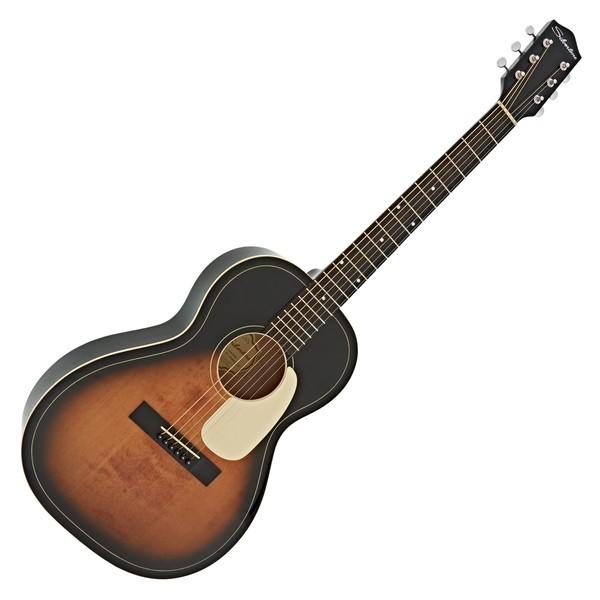
As a seasoned guitarist and veteran editor, I can’t emphasize enough the importance of understanding your instrument’s aspects in depth. Possessing extensive knowledge about the instrument doesn’t just enhance your skills as a musician but also deepens your bond with the tool, offering an intimate connection with your music. In the journey of a musician, this connection proves a crucial, soulful ingredient.
When it comes to the coveted Silvertone acoustic guitars, all of their allures boil down to their impeccable features and specifications. But before we delve into the enticing world of Silvertone guitars, let’s ask the question – Do you understand ‘the language of luthier’? To truly comprehend what sets these magnificent instruments apart, it’s crucial to decode this jargon as we dissect the compelling features of Silvertone guitars.
Engelmann Spruce Top Guitar:
This is where the essence of Silvertone guitars comes into play. The construction of each Silvertone guitar is as soulful as the music it generates. The top, or soundboard, plays a pivotal role in delivering the instrument’s overall voice. Known for its light color and straight grain, Engelmann spruce is the wood of choice for Silvertone’s top. It’s pronounced even tonality, offering a smooth, mature tone with enhanced sustain, is precisely what makes a Silvertone guitar resonate with such distinction.
Mahogany Back and Sides Guitar:
Complementing the Engelmann spruce top are the mahogany back and sides. This wood combination perfectly balances the warm, resonant tones produced by the spruce top. Known for its strength and density, the use of mahogany contributes a remarkable depth and clarity to the guitar’s voice. When you hold a Silvertone guitar in your hands, the harmonic richness that these acoustic guitar tone woods offer is instantly palpable!
But what truly sets Silvertone guitars apart are the fine details and meticulous construction. Each element, from the precisely inlaid frets to the delicately shaped neck, contributes to the instrument’s comfortable playability and artistic aesthetics. Features like their tuners, uniquely designed to provide stable and accurate tuning, further solidify their premium positioning in the world of acoustic guitars.
These notable characteristics, coupled with the attractive finishing and impressive durability of Silvertone guitars, all converge to deliver an unrivaled playing experience. Decoding the language of luthier and truly understanding the passion and craftsmanship that go into each Silvertone guitar would no doubt make the melodies you play sound even sweeter, charging every chord with a deeper sense of connection and mastery.
Stay tuned for a look at Pricing and Where to Buy, where we will navigate the landscape of options available for procuring your very own Silvertone. The journey is just getting started!
Pricing and Where to Buy
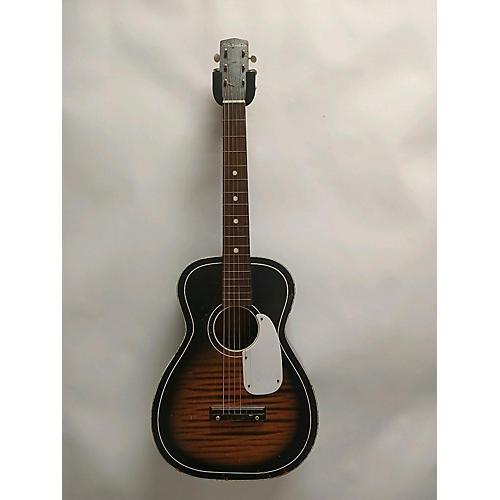
The process of acquiring a guitar is much like a fine dance, a two-step process where researching ‘Silvertone guitar prices’ leads you to consider the ‘acoustic guitar buying guide’. What is the real cost of Silvertone acoustic guitars? And where do you get the best bang for your buck?
Over the years, I’ve learned the ins and outs of acquiring guitars. Combine this expertise with my knowledge of Silvertones, and I’ll guide you into finding your perfect six-stringed companion. Let’s start with the basics – a new Silvertone guitar would generally range from $150 to $300 dollars, depending on the model and its features. However, you may be tempted to hunt down a vintage model, which could cost you anywhere from $200 to $500. There’s always a catch, isn’t there?
Here’s a little secret: the price of a guitar isn’t always a straightforward reflection of its quality. Remember, the value of an instrument is often linked to how much you’re willing to invest in it, both financially and emotionally. And sometimes, a higher price tag doesn’t automatically make for a better guitar – that’s why researching is so crucial.
Did you know that acquiring a guitar could be akin to a game of chess? It’s all about making the right moves at the right time and the right place. Let’s unravel this grand strategy together. Navigating the world of online purchasing can be a precarious game, but sometimes it’s the best shot at snagging a good deal. Renowned online platforms like Amazon, eBay, or Reverb often list a wide variety of Silvertone acoustic guitars. Used Silvertones can also be found in second-hand stores and pawnshops.
However, online purchasing and second-hand buys come with their fair share of drawbacks – you can’t really ‘feel’ the instrument or hear its tonal qualities before making the purchase. That’s when brick-and-mortar stores come in handy. The opportunity to strum the strings, to listen to its voice, to feel the weight and gloss of the guitar in your hands – nothing can replace the visceral, personal experience of trying out a guitar in an actual store.
In conclusion, before making a purchase, consider your budget and the places to buy – online for convenience, physical stores for that ‘touch and feel’ experience. In the end, it’s all a balancing act, like a delicate dance or a chess game. But with the right amount of research, patience, and some savvy shopping, your perfect Silvertone acoustic guitar is merely a thoughtful move away.
Maintenance and Care
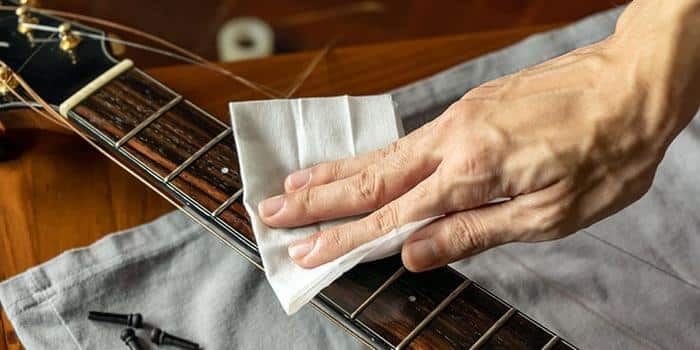
Being a guitarist means being a custodian. The care that goes into maintaining these instruments is crucial. Yes, creating sound is a guitarist’s primary concern. But keeping the guitar in its prime condition is a strain of the same melody. I’ve been walking this path for years, learning, experimenting, and growing as both a guitarist and a custodian. Now, I will share that knowledge with you. In particular, we will navigate the corridors of Silvertone guitar maintenance.
Did you know that your guitar is just like a living entity? It needs your care and nurturing to sing its most beautiful songs. Let’s explore the art of guitar custodianship together.
The first step in Silvertone guitar maintenance is protecting your guitar from extreme temperatures and humidity, since they can warp the wooden body. This might sound minor, but it can drastically affect your guitar’s tone, action, and intonation. Hence, your guitar case becomes an essential investment rather than just a means of transport.
Next, comes the crucial part – the guitar setup. It involves adjusting the strings, the bridge, and the truss rod to ensure hassle-free playability. Having your Silvertone setup regularly and professionally ensures longevity and optimal sound. Often overlooked, but very important, is regular cleaning. Wiping down your guitar with a lint-free cloth after every session prevents grime and sweat from eating into the wood and affecting the sound output.
Maintenance is vital and, in a way, echoing the joy and pride of ownership. Indeed, being a custodian gives me the same satisfaction as playing a perfect chord progression. How you care for your instrument is a reflection of your commitment to your art.
Caring for your Silvertone goes beyond the routine maintenance, though. It involves appreciating the instrument and understanding its history. Every scratch, every ding has a story – a concert, a rehearsal, a private jamming session. And in maintaining its pristine essence, you are adding yet another chapter to the Silvertone saga. You are becoming a part of its history, its story.
So, let’s not forget – to keep your guitar singing, you don’t just strum; you care and maintain. Let’s work towards becoming the ultimate custodians of our Silvertones. After all, every beautiful song we coax out of these strings is equally a testament to our dedication to guitar maintenance as it is to our craftsmanship.
User Reviews and Opinions

As we dive deeper into Silvertone’s legacy, I find it important to not only lean on the technical specifications or the company’s history but also to bring forth the voice of my fellow musicians and Silvertone users. As a community builder in the world of music, my journey has shown me the importance of considering other perspectives, and in this instance, the emphasis is on other musicians’ insights concerning Silvertone acoustic guitars. With numerous user opinions out there, it’s time to sift through the babel of voices and tap into the reality behind Silvertone guitars.
Do the voices of thousands of Silvertone users carry any weight? Based on my years of playing, reviewing, and talking guitars, I would resoundingly say yes! The firsthand feedback from fellow musicians dealing with the daily ins and outs of these instruments can provide a much-needed reality check, and a degree of insight no professional review could imitate. Let’s therefore delve into the world of Silvertone guitar reviews, and bridge the gap between my experience and the broader guitar community’s insights.
Numerous Silvertone guitar forums where I lurk, brim with diverse insights into the user experience of Silvertone acoustics. A recurring theme? The blend of affordability and quality many users have found in their Silvertone guitars. Echoing through endless pages of enthusiasts’ posts, they laud the admirable craftsmanship and balanced acoustic tone Silvertone offers without breaking the bank. This slots harmoniously with my own Silvertone journey, where I discovered an instrument eager to punch above its weight.
However, no journey is free from bumps. Some user reviews on Silvertone guitars speak of issues with action and fret buzzing. As a seasoned player myself, I can understand the frustration. Guitar setup is a personal subject, and a poorly set up instrument can indeed be a barrier. But my experience whispers a word of advice here – Silvertone guitars typically need some initial setup love to unlock their true potential. Once sorted, many users, including myself, have found themselves with a reliable piece of art, sounding as lovely as it looks.
That being said, your perception of Silvertone, like mine, will ultimately depend on what you seek in a guitar. Guitars are deeply personal, and there isn’t a one-size-fits-all. From the beaming reviews of some to the critical notes of others, one thing is certain: Silvertone has carved out a place for itself in the guitar world. This cements my view that these guitars, while not perfect, have earned their stripes.
As we move forward in this review, let’s remember this tapestry of voices in the background. Whether my insights or those of my fellow musicians, together they paint a picture that’s closer to the real deal. In the end, Silvertone guitars, like all things music, are about personal connection, sound, and soul. And that’s pretty special.
Collectibility and Comparison
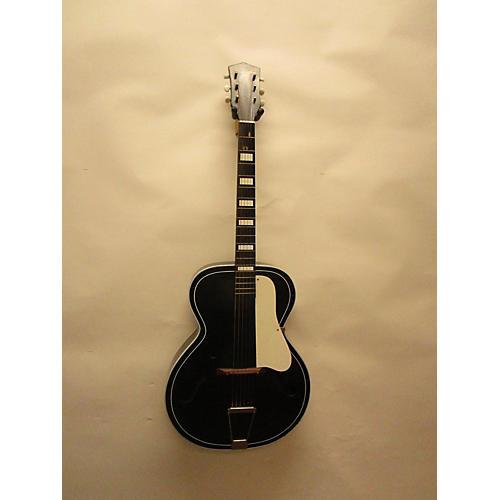
In pursuing my passion for guitars, I’ve ventured into collecting a myriad of brands. The search for that harmonic blend of tone and resonance has taken me on a journey steep through the terrains of guitar history and craftsmanship. The touch, the play, the visceral feel; each guitar resonates with a unique story. Today, I’m focusing on Silvertone acoustic guitars, sharing my findings on the collectibility and quality that places Silvertone amongst the noteworthy within this vibrant industry.
Silvertone guitar collectibility stands on a platform built by years of musical history. Revered in the past for their affordable and quality instruments, Silvertone has an undeniable resonance with generations of guitarists. This brand built its reputation by providing an entry-point for many budding musicians, which now translates into a palpable sense of nostalgia in the collector’s market. Owing to the significant role they played in the evolving landscape of music, Silvertone guitars have become folkloric. The artistry, the history, and the sentimentality combined strike a chord that enchants collectors, beginners, and professionals alike.
Moving on to Silvertone guitar quality, it’s an undisputed fact that these guitars deliver reliable performance. Crafted with an attention to detail, Silvertone guitars resonate with a balanced, rich tone that can compete with the best in the industry. Despite the ever-evolving technological advancements in the guitar-making process, Silvertone has maintained its commitment to preserving the essence of old-school craftsmanship, striking a harmonious balance between tradition and modernity.
Does brand loyalty lead to personal satisfaction or bias? Let’s put Silvertone under the microscope and compare it with other giants of the industry.
When it comes to Silvertone guitar comparisons, I’ve pitched the brand against many of its contemporaries, ranging from similarly affordable brands to high-end stalwarts. From Gibson and Fender to Yamaha and Ibanez, each brand brings something unique to the table in terms of sound, build, and overall quality. However, Silvertone has never fallen short, competing admirably in most aspects. The rich tone, easy playability, comforting resonance, and high standard of build quality make Silvertone guitars a competitive choice for both novices and professionals.
In conclusion, Silvertone’s unique charm is rooted in its historical significance, quality craftsmanship, and captivating tonal colours. As a collector and player, I always look for a guitar that offers both an appealing aesthetic and an enriching play experience. Silvertone certainly delivers on those fronts, carving out its niche and holding its own in the pantheon of great guitar brands. However, as always, the choice of a guitar is an intimately personal decision, one best made with the benefit of hands-on experience and a resonance with your musical soul.
FAQs
Who Manufactures Silvertone Acoustic Guitars?
How is the Sound Quality of Silvertone Acoustic Guitars?
Are Silvertone Acoustic Guitars Suitable For Beginners?
What are the Most Popular Silvertone Acoustic Guitar Models?
Conclusion
What does your heart say about Silvertone guitars? As we wrap up this exploration, let me share why my heart sings a Silvertone song. Drawing from my decades-long journey as a guitarist and educator, I am reminded of the distinctive sound of Silvertone guitars. Each strum evoking a sense of nostalgia and warmth, reaffirming my belief in their exceptional craftsmanship and tonality.
Silvertone acoustic models have a spectrum of unique features that cater to a variety of genres and playing styles. The Silvertone 600 Series stands out to me as a representation of their commitment to accessibility without compromising on quality. Its orchestra body design embodies a depth of sound that resonates with both beginners and seasoned players alike.
I strongly believe that choosing a guitar is a personal journey. The sound, the feel, the vibe – it all has to connect with you. In my many years of teaching and playing, Silvertone has consistently touched the hearts of those who dare to try.
Sifting through forums and customer reviews, the valid praise for Silvertone’s affordability and unique vintage appeal is a testament to their timeless appeal. Sure, there are countless guitars in the market, yet the charm of a Silvertone can be a beautiful addition to any collection or a great stepping stone for beginners.
In wrapping up, I urge you to give a Silvertone a try, be it for its vintage charm, resonant sound, or the simple joy of playing an instrument that has stood shoulder to shoulder with some of the biggest names in music history. Trust me, your journey with the Silvertone will be just as special as mine has been.

Is the Silvertone Songwriter Series Parlor Acoustic Satin Natural Guitar all solid woods, both top wood, back wood and sides?
Yes, the Silvertone Songwriter Series Parlor Acoustic Satin Natural Guitar features all solid woods for both the top, back, and sides.